1893
The floods of 1893 caused large amounts of damage throughout Queensland, especially in Brisbane. The first Albert Bridge at Indooroopilly across the Brisbane River was swept away by floodwaters. The following railways opened:
• 1 April 1893: Extension of Biggenden branch to end of rails at Degilbo
• 1 August 1893: Extension of Cairns Railway to Mareeba
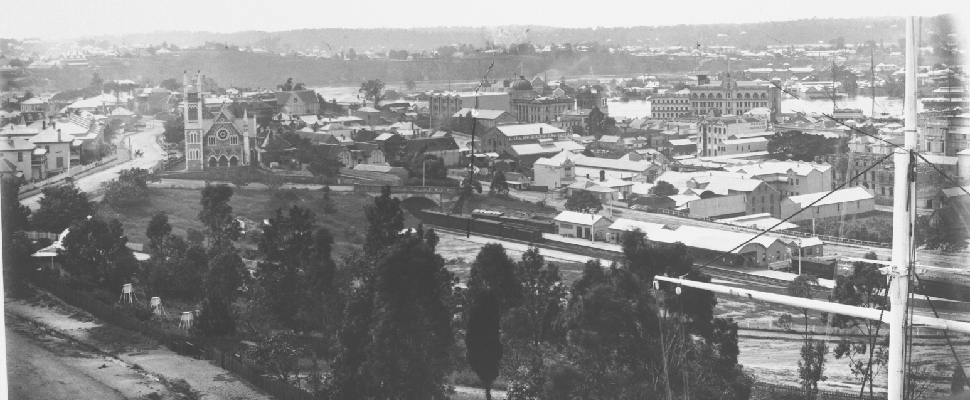 Image captionThe flooding in Brisbane, in1893, captured by a photographer from on top of the old Windmill on Wickham Tce. The view across to the Brisbane River, takes in the original Central railway station.
Image captionThe flooding in Brisbane, in1893, captured by a photographer from on top of the old Windmill on Wickham Tce. The view across to the Brisbane River, takes in the original Central railway station.
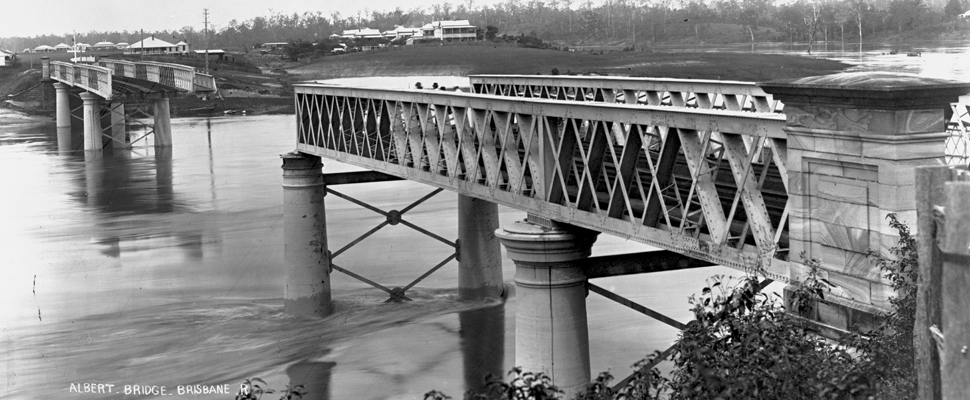 Image captionAfter the damage has been done. The original Albert Bridge across the Indooroopilly was swept away by the floods of February, 1893. Just after the centre spans were carried off downstream, sightseers appear to survey the damage to the bridge. It would take another two years for a new bridge to be constructed.
Image captionAfter the damage has been done. The original Albert Bridge across the Indooroopilly was swept away by the floods of February, 1893. Just after the centre spans were carried off downstream, sightseers appear to survey the damage to the bridge. It would take another two years for a new bridge to be constructed.
1894
9 July 1894: The private branch from Bundaberg to Millaquin opened (part purchased by Queensland Railways in 1912).
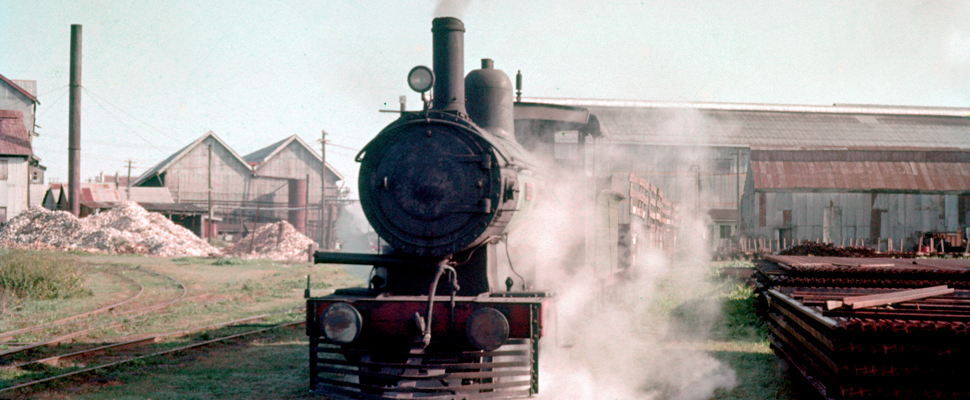 Image captionIn 1963, photographer Brian Webber captured B13 class steam locomotive No.130 at work around the Millaquin sugar mill, in Bundaberg. No.130 was purchased from Queensland Railways, in 1950, by Millaquin sugar mill. It was originally a Dubs locomotive of 1886, in service, in1888, and remained in service until 1965.
Image captionIn 1963, photographer Brian Webber captured B13 class steam locomotive No.130 at work around the Millaquin sugar mill, in Bundaberg. No.130 was purchased from Queensland Railways, in 1950, by Millaquin sugar mill. It was originally a Dubs locomotive of 1886, in service, in1888, and remained in service until 1965.
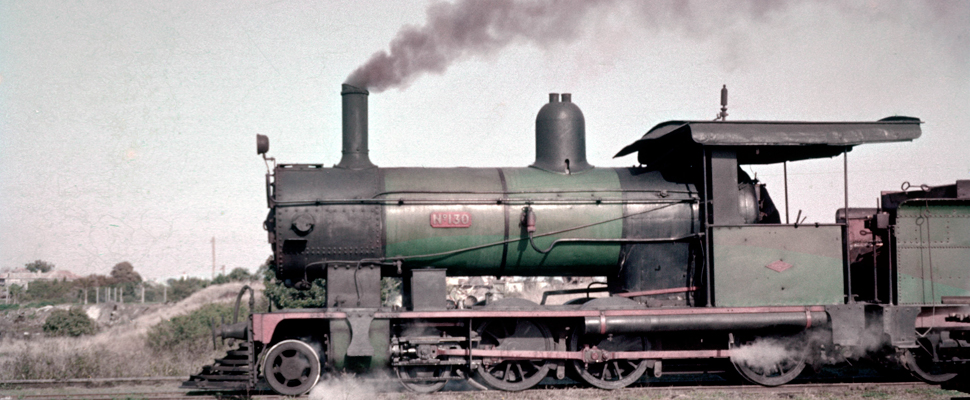 Image captionIn 1963, photographer Brian Webber captured B13 class steam locomotive No.130 at work around the Millaquin sugar mill, in Bundaberg. No.130 was purchased from Queensland Railways, in 1950, by Millaquin sugar mill. It was originally a Dubs locomotive of 1886, in service, in1888, and remained in service until 1965.
Image captionIn 1963, photographer Brian Webber captured B13 class steam locomotive No.130 at work around the Millaquin sugar mill, in Bundaberg. No.130 was purchased from Queensland Railways, in 1950, by Millaquin sugar mill. It was originally a Dubs locomotive of 1886, in service, in1888, and remained in service until 1965.
1895
The 1890s depression had put a stop to rail building, leaving the colony with one connected system that linked Brisbane with New South Wales, via Wallan-garra, Charleville, the South Coast, and northwards to Bundaberg and Mount Perry after the Burnett River bridge opened in 1891. Further extension north to Gladstone halted for lack of funds. The major inland lines routes were from Brisbane to Charleville, Wallangarra and Bundaberg, Rockhampton to Longreach and Townsville to Hughenden.
A result of the financial constraints of the era and to help defray costs, the Railways Guarantee Act was passed in 1895, by the Queensland government. Under this Legislation, new branch lines were built on a guarantee principle under which local ratepayers paid half of any shortfall in working expenses and also paid the interest on capital. Such lines included branches to Allora, Pialba, Enoggera, and Mount Morgan. The intention of the Legislation was to discourage unprofitable lines from being constructed, but ultimately many of these lines were eventually taken over by the Queensland Railways.
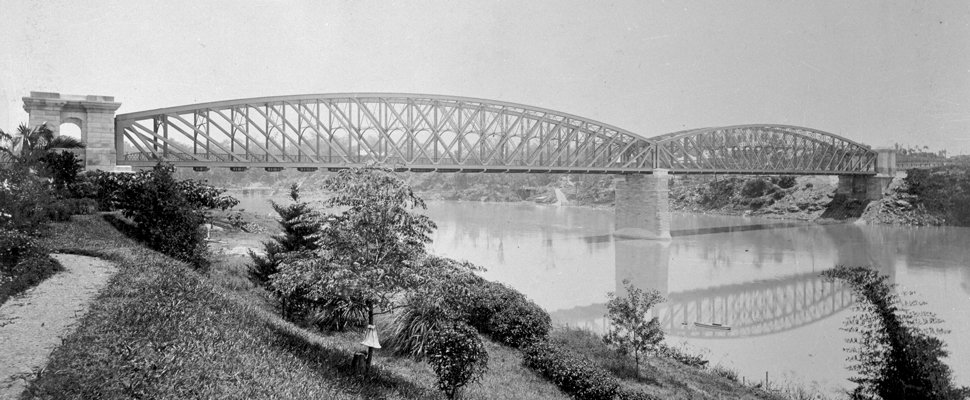 Image caption1895 also marked the opening of the new Albert Bridge across the Brisbane River, between Indooroopilly, and Chelmer. This photo shows it in 1896 when still new.
Image caption1895 also marked the opening of the new Albert Bridge across the Brisbane River, between Indooroopilly, and Chelmer. This photo shows it in 1896 when still new.
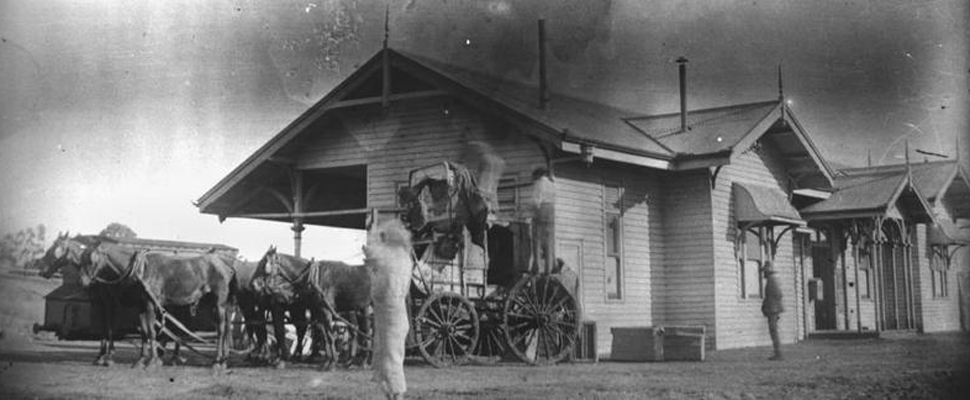 Image captionThought to have been taken in 1895, a Cobb & Co coach unloads its mail and other goods after a journey to the original Charleville railway station.
Image captionThought to have been taken in 1895, a Cobb & Co coach unloads its mail and other goods after a journey to the original Charleville railway station.
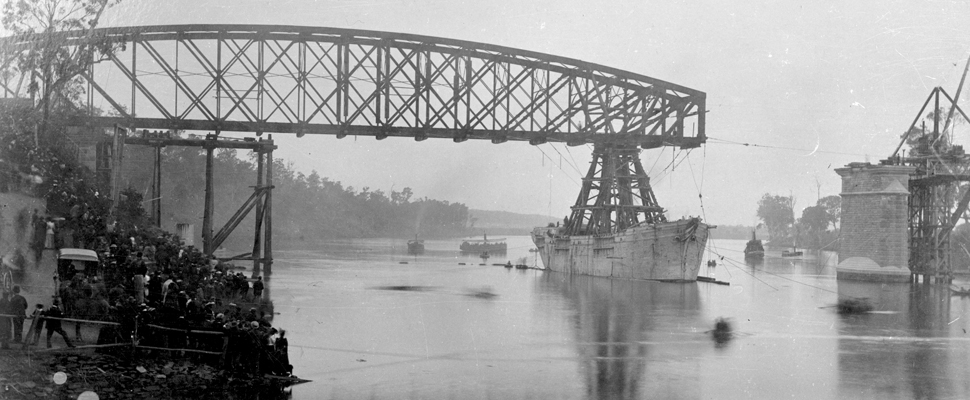 Image captionThe Albert bridge was completed and tested officially on 1 July 1876 when a deflection of 3/4 inch was recorded with a load of 266 tons. At the official opening on 5 July, Governor Cairns named it the Albert Bridge in honour of Prince Albert. The northern truss was floated into position. The shore end rested on two trolleys, and when the tide was at its highest, specially constructed staging on an old barque took the weight of the other end of the truss from temporary piles. Winches were then used to pull the hulk across the river toward the centre pier, to which the truss was attached.
Image captionThe Albert bridge was completed and tested officially on 1 July 1876 when a deflection of 3/4 inch was recorded with a load of 266 tons. At the official opening on 5 July, Governor Cairns named it the Albert Bridge in honour of Prince Albert. The northern truss was floated into position. The shore end rested on two trolleys, and when the tide was at its highest, specially constructed staging on an old barque took the weight of the other end of the truss from temporary piles. Winches were then used to pull the hulk across the river toward the centre pier, to which the truss was attached.
1896
1896 saw the opening of the following railway lines:
• 1 June 1896: Extension of Isis branch Childers to Cordalba
• 1 August 1896: Gladstone to Iveragh opened
• 18 December 1896: Opening of branch from Colton to Pialba
Not long after the completion of the line to Childers, agitation began to extend the line further on to Apple Tree Creek (Cordalba). Proposals included moving sugar cane to the Fairymead mill from the Isis plantations, as well as constructing a private sugar railway.
In 1889-90, and again in 1894-5 surveys were carried out to extend the line on to Cordalba. Unlike the line to Childers, construction would not be as easy due to the rougher nature of ground that was to be traversed.
Local sugar interests in the area however guaranteed that there would be traffic offering for extension of the railway. For instance in 1894, the railways were making arrangements to transport some 20,000 tons of cane from Childers to Bundaberg.
The extension to Cordalba was approved by Parliament in 1895, and the seven mile line opened to traffic on 1 June 1896. The contractors responsible for construction were Vallely and Bowser, who also built the Mayne Junction to Enoggera railway in Brisbane.
For the opening, a special train was run to Cordalba, and the customary banquet was held. On opening day the weather was bitterly cold, and the local schoolchildren attended the opening. A daily train service was introduced, running from Cordalba to Isis Junction on the main line, and return.
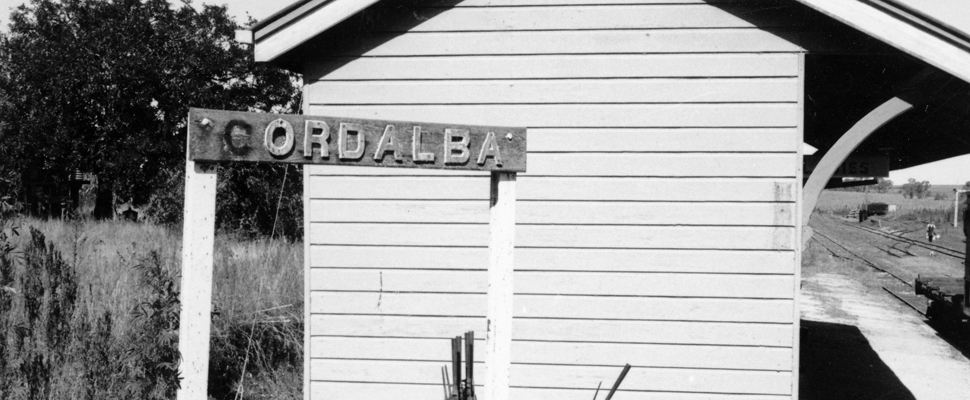 Image captionPhotographer Brian Webber captured Cordabla before the closure of the line in 1964.
Image captionPhotographer Brian Webber captured Cordabla before the closure of the line in 1964.
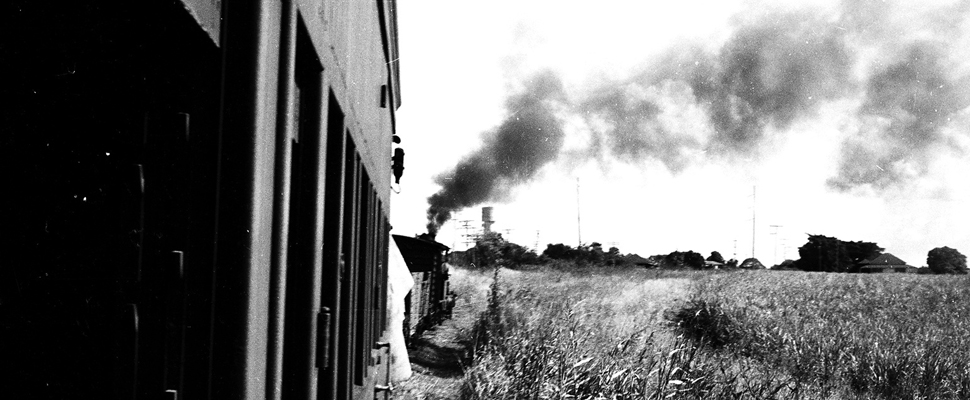 Image captionPhotographer Brian Webber captured steam locomotive PB15 No.554 near Childers, in 1964.
Image captionPhotographer Brian Webber captured steam locomotive PB15 No.554 near Childers, in 1964.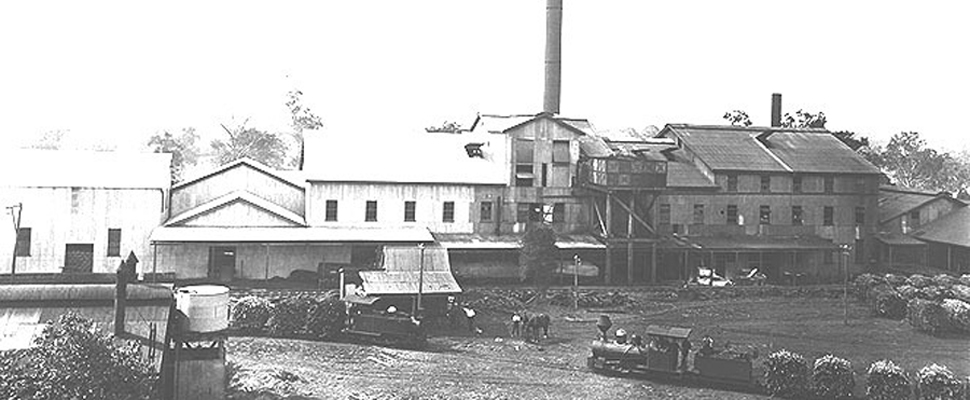 Image captionIdentified as being 'Childers' Sugar Mill, (possibly CSR Huxley Mill), photographed in the early part of the 20th century. In the foreground can be seen a Hudswell Clarke tender locomotive.
Image captionIdentified as being 'Childers' Sugar Mill, (possibly CSR Huxley Mill), photographed in the early part of the 20th century. In the foreground can be seen a Hudswell Clarke tender locomotive.
1897
Towards the end of the 1890s, the pace of railway construction picked up in the wake of the recession of the early part of the decade.
• 1 January 1897: Purchase of Bundamba Swanbank Coal Railway built in 1880s
• 27 April 1897: Opening of Allora Branch
• 3 May 1897: Opening of Cairns Mulgrave (Gordonvale) Local Authority Tramway
• 1 September 1897: Opening of Railway to Pinkenba
• 1 October: Completion of Bundaberg Gladstone Railway
In 1897, Racecourse station was renamed to Ascot [after the famous racing track in England], and in the same year the railway line was extended to Pinkenba. Following lobbying from the Hamilton Town Council, a second railway station was constructed on the western side of the line in 1913-14, that was opened in 1914. The fact that the then Commissioner for Queensland Railways lived locally also meant that Ascot would get a modern station as well.
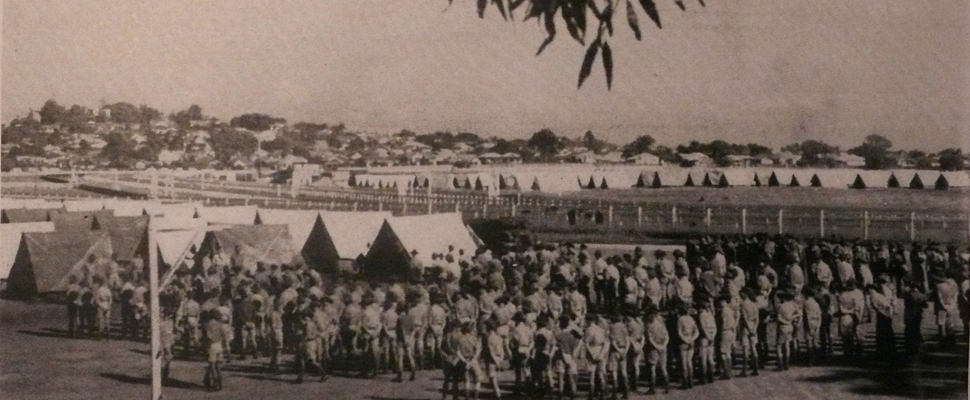 Image captionPhotograph from the Macarthur Museum, Brisbane, showing a military encampment at Ascot racecourse, in 1942.
Image captionPhotograph from the Macarthur Museum, Brisbane, showing a military encampment at Ascot racecourse, in 1942.
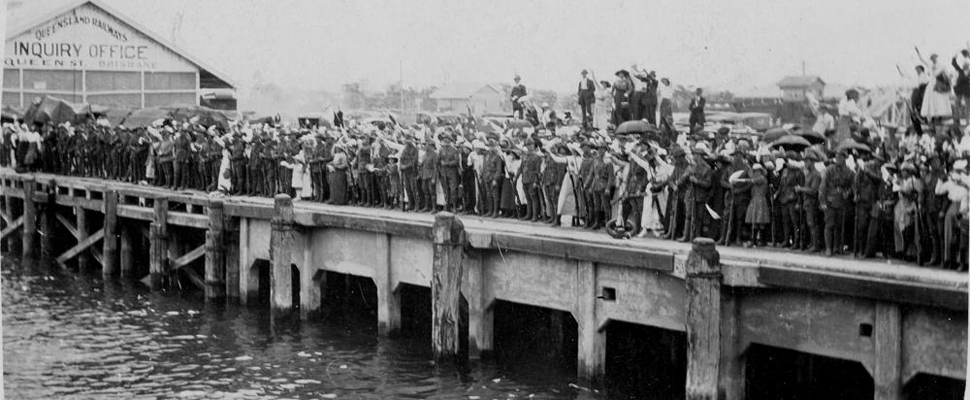 Image captionCrowd bidding farewell in the rain on Pinkenba (railway) wharf, 1916. John Oxley Library Neg 33441.
Image captionCrowd bidding farewell in the rain on Pinkenba (railway) wharf, 1916. John Oxley Library Neg 33441.
1898
The following railway lines opened in 1898:
• 1 January 1898: Opening port railway from Nankin to Broadmount
• 23 March 1898: Opening of Tivoli coal railway, North Ipswich
• 10 October 1898: Completion of Western Railway to Cunnamulla
• 24 October 1898: Coordinated rail steamer service via Gladstone to north inaugurated
• 26 November 1898: Completion of railway including rack section Kabra to Mount Morgan.
The railway linking Mount Morgan to Rockhampton, including the Rack Railway section opened on 26 November 1898. The distance from Kabra to Moonmera was 9 miles, from Moonmera to Moongan 1.5 miles and from Moongan to Mount Morgan 2.5 miles, which was a total distance of about 13 miles (21 km).
The line from Moonmera to Moongan was very steep, having a gradient of 1:16.5, and a special 'rack' section with a central toothed rail, which meshed with a pinion cog on the locomotive. The rack section and the standard steam locomotive required assistance from an Abt rack engine to handle the train up and down the Razorback range. In descending the range, the Abt rack engine was attached to the front of the standard engine, while ascending the range, the rack engine was attached to the rear of the train.
The Abt rack locomotive, developed principally in Switzerland, was a powerful locomotive, having adhesive wheels and an independently powered engine beneath the boiler which drove pinions (toothed wheels) set between the adhesive wheels.
The railway with the rack section, was the only rack railway in Queensland. The only other rack railway in Australia was on the Mount Lyell Company's Queenstown to Strahan private railway.
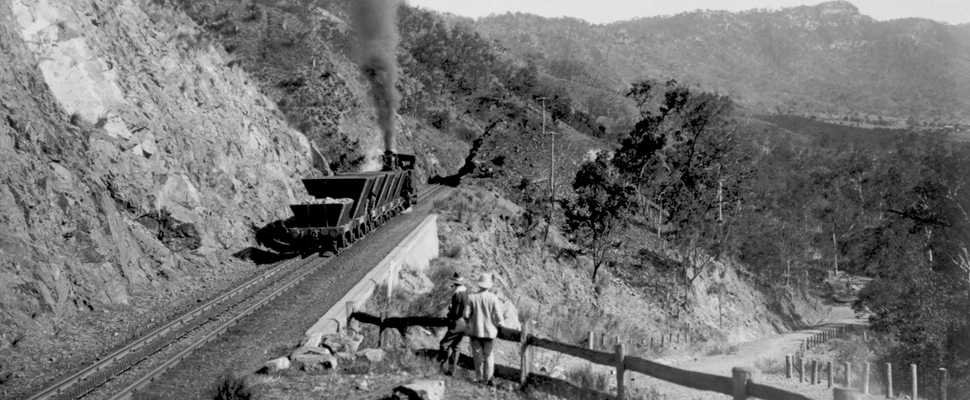 Image captionAround 1912, one of the 6D13½ class rack locomotives propels a couple of wagons up the rack section.
Image captionAround 1912, one of the 6D13½ class rack locomotives propels a couple of wagons up the rack section.
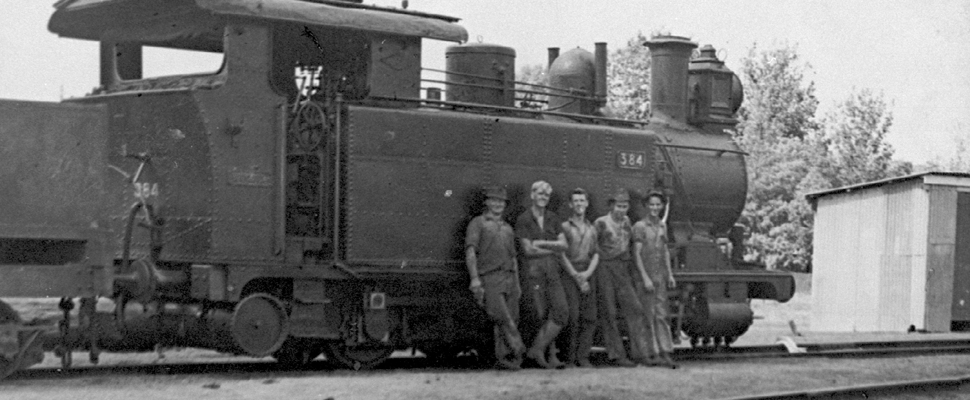 Image captionAt the end of its working life 6D13½ No. 384 was photographed in Mount Morgan yard, probably around the time of its withdrawal at the end of 1952.
Image captionAt the end of its working life 6D13½ No. 384 was photographed in Mount Morgan yard, probably around the time of its withdrawal at the end of 1952.
1899
The following railway lines opened in 1899:
• 4 February 1899: Opening of branch from Mayne to Enoggera in Brisbane
• July 1899: First electrically lit carriage begins running
• 5 July 1899: Completion of Railway from Townsville to Winton
• 6 November 1899: Opening Alexandra Bridge links Emu Park Railway to Central Railway.
The tender for construction of the Rockhampton Junction Railway was awarded to GC Willcocks in 1897. George Willcocks was one of Queensland's most prolific railway contractors, having been involved in the construction of various sections of the North Coast Line, as well as railway lines in the Brisbane area. The contract also involved the construction of the branch to Broadmount, the Denison Street line, and the Alexandra Railway Bridge.
Construction of the bridge was delayed until 1898 due to flooding on the Fitzroy River. The bridge was designed by chief engineer HC Stanley. The first of the main spans was floated into position on 14 June 1899. The method used to place the main spans was similar to that used for the Albert Bridge, across the Brisbane River, where a ships hulk was employed to float the span into position.
The Rockhampton Junction Railway was officially opened on 6 November 1899 with a special ceremony held on the southern end of the railway extension. A double headed train and twelve carriages left the Stanley Street Station and broke through a ribbon on the Fitzroy railway bridge. At the time of its opening, no official name for the bridge had been decided, but it had been suggested that it be named after Alexandra, Princess of Wales, after consulting with the Premier earlier in the day.
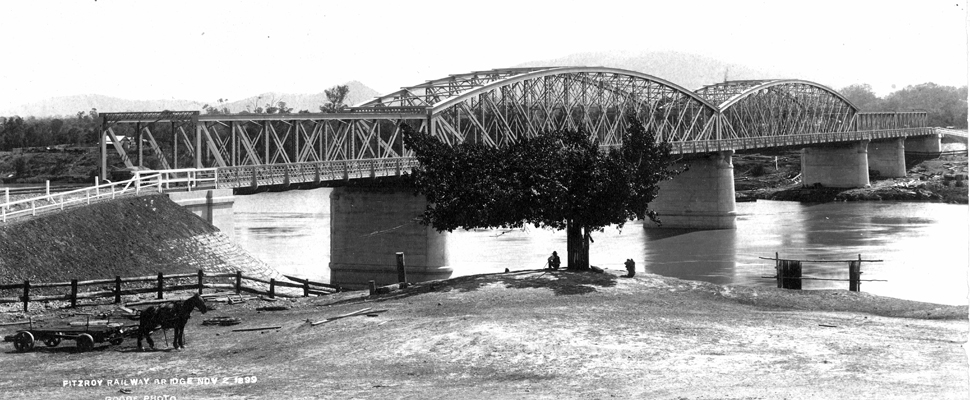 Image captionThe Alexandra railway bridge photographed not long after its completion.
Image captionThe Alexandra railway bridge photographed not long after its completion.
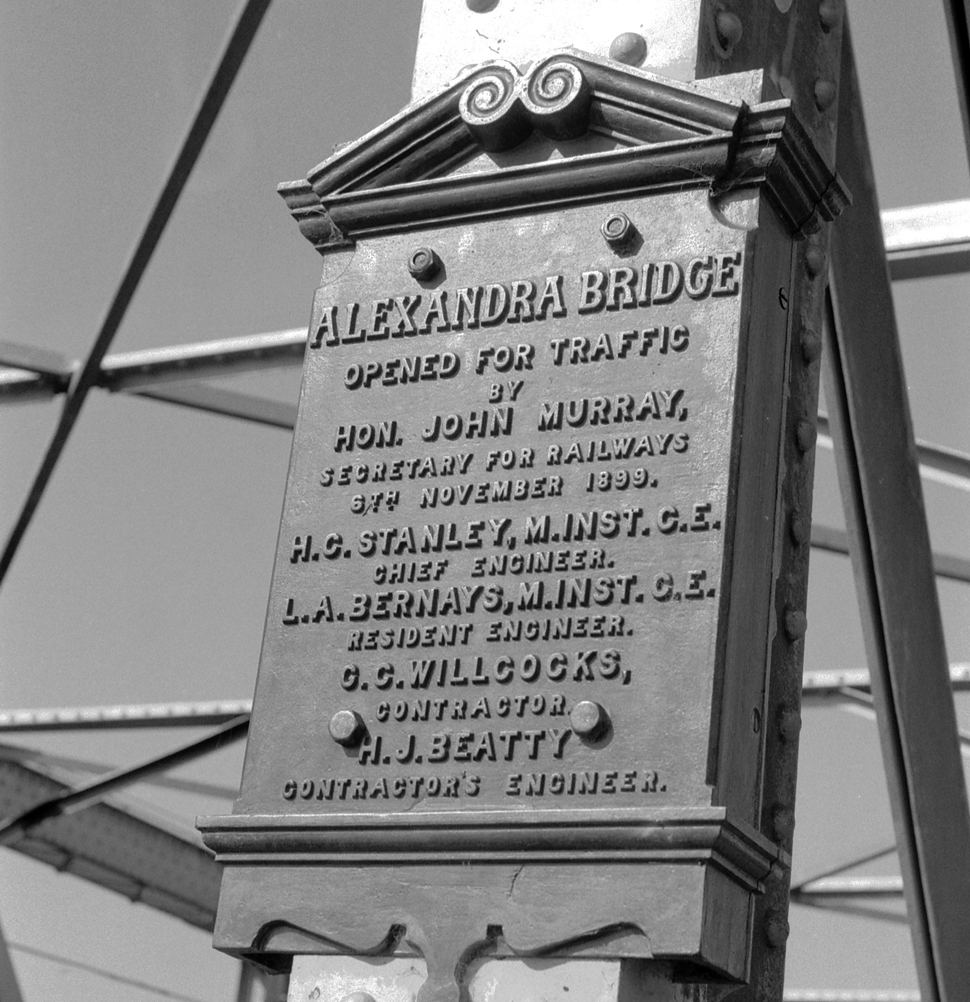 Image captionThe opening plaque on Alexandra railway bridge.
Image captionThe opening plaque on Alexandra railway bridge.
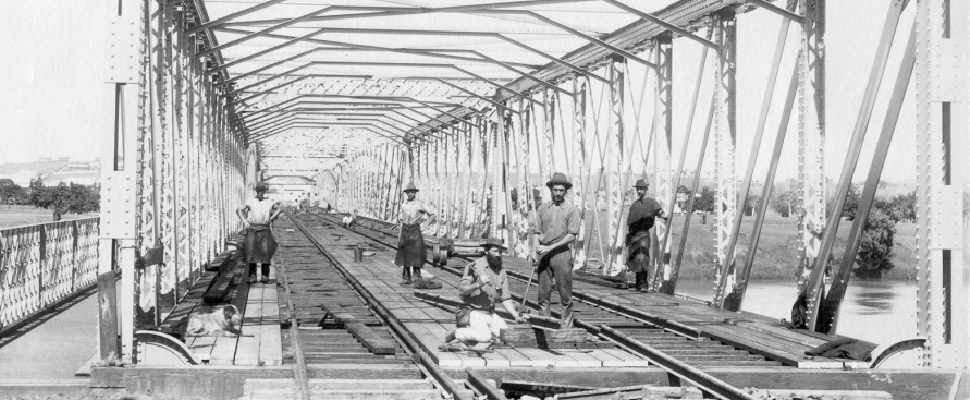 Image captionA group of 'navvies', (fettlers), attend to final track laying on the Alexandra bridge, in 1899.
Image captionA group of 'navvies', (fettlers), attend to final track laying on the Alexandra bridge, in 1899.